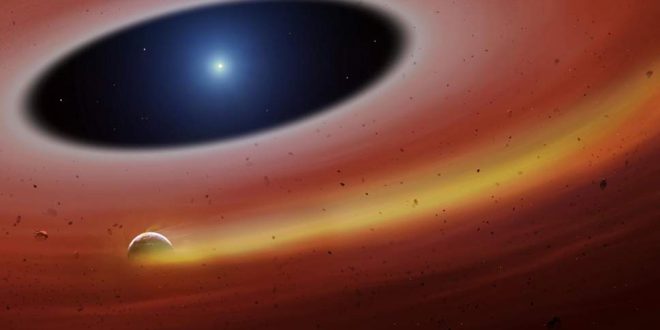The ‘heavy metal’ composition of the planet is thought to have allowed it to survive the intense events it has undergone
Scientists have spotted a chunk of a distant planet that could offer a hint at the future of our Solar System.
The fragment, seen circling a dead star 400 light years away, is thought to be rich in the heavy metals iron and nickel, researchers say.
That strange, heavy metal composition is thought to have allowed it to survive the destruction of its planetary system, according to those who found it. The body is circling around a white dwarf star “closer than we would expect to find anything still alive”, scientists said.
And the end of that system could be a hint at what will happen to our own Solar System, six billion years from now.
The fragment of planet is thought to have survived a cataclysm that destroyed its entire system, after the death of its host star. The chunk is thought to have once belonged to a larger planet, and would not have been expected to survive given it orbits much closer to its star than previously thought possible, with years that last just two hours.
The new discovery, reported in the journal Science, marks the first time that scientists have used spectroscopy to find a solid body that is in orbit around a white dwarf. That technique allowed them to pick up the slight variations in light to identify the gas that is being generated by the fragment of planet.
The object was spotted after scientists, using the Gran Telescopio Canarias in La Palma, looked up towards a disc of debris that is spinning around a white dwarf some 410 light years away. That mass was formed by a grouping of elements such as iron, magnesium, silicon, and oxygen, the elements that helped build the Earth and most other rocky bodies.
As they looked up, researchers could see a ring of gas streaming out of a solid object, like the tail that follows a comet. The researchers found the gas could be coming out of the object itself or be the dust that evaporates as it hits other debris in the disc.
The fragment must be at least a kilometre across, the scientists say. But it could be far bigger: as much as a few hundred kilometres across, a similar size as the biggest asteroids in our solar system.
The dead star it orbits around, a white dwarf, is formed when a sun like ours burns out all of its fuel and sheds its outer layers. That leaves behind a dense core that cools with time.
This one has shrunk so much that the fragment orbits inside the area that the sun once stood. But it was probably further afield, part of a bigger object that was part of a solar system like ours that was ripped apart when the star started to cool.
“The star would have originally been about two solar masses, but now the white dwarf is only 70% of the mass of our Sun. It is also very small – roughly the size of the Earth – and this makes the star, and in general all white dwarfs, extremely dense,” said lead author Dr Christopher Manser, a Research Fellow in the Department of Physics, said.
“The white dwarf’s gravity is so strong – about 100,000 times that of the Earth’s – that a typical asteroid will be ripped apart by gravitational forces if it passes too close to the white dwarf.”
Researchers were shocked to find such an object so close and able to go on surviving.
“The planetesimal we have discovered is deep into the gravitational well of the white dwarf, much closer to it than we would expect to find anything still alive. That is only possible because it must be very dense and/or very likely to have internal strength that holds it together, so we propose that it is composed largely of iron and nickel,” said Boris Gaensicke, co-author from the Department of Physics.
“If it was pure iron it could survive where it lives now, but equally it could be a body that is rich in iron but with internal strength to hold it together, which is consistent with the planetesimal being a fairly massive fragment of a planet core. If correct, the original body was at least hundreds of kilometres in diameter because it is only at that point planets begin to differentiate – like oil on water – and have heavier elements sink to form a metallic core.”
The fragment could be a glimpse at the other planets that could be around in other solar systems. And it also hints at the future of our own.
“As stars age they grow into red giants, which ‘clean out’ much of the inner part of their planetary system. In our Solar System, the Sun will expand up to where the Earth currently orbits, and will wipe out Earth, Mercury, and Venus. Mars and beyond will survive and will move further out,” Dr Manser said.
“The general consensus is that 5-6 billion years from now, our Solar System will be a white dwarf in place of the Sun, orbited by Mars, Jupiter, Saturn, the outer planets, as well as asteroids and comets. Gravitational interactions are likely to happen in such remnants of planetary systems, meaning the bigger planets can easily nudge the smaller bodies onto an orbit that takes them close to the white dwarf, where they get shredded by its enormous gravity.
“Learning about the masses of asteroids, or planetary fragments that can reach a white dwarf can tell us something about the planets that we know must be further out in this system, but we currently have no way to detect.”
The Independent
 Lebanese Ministry of Information
Lebanese Ministry of Information



